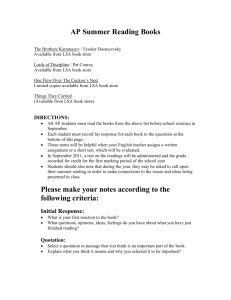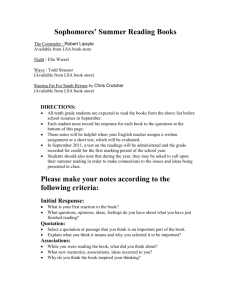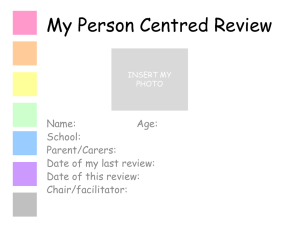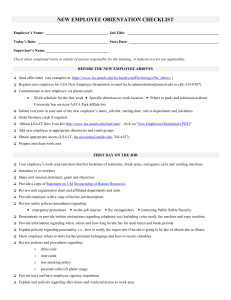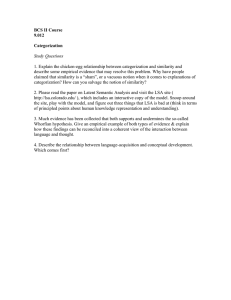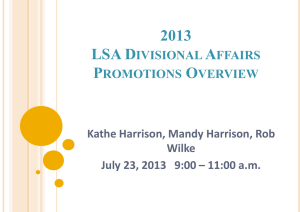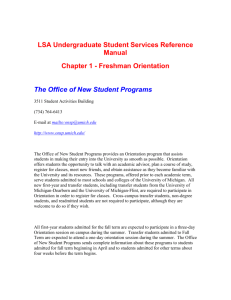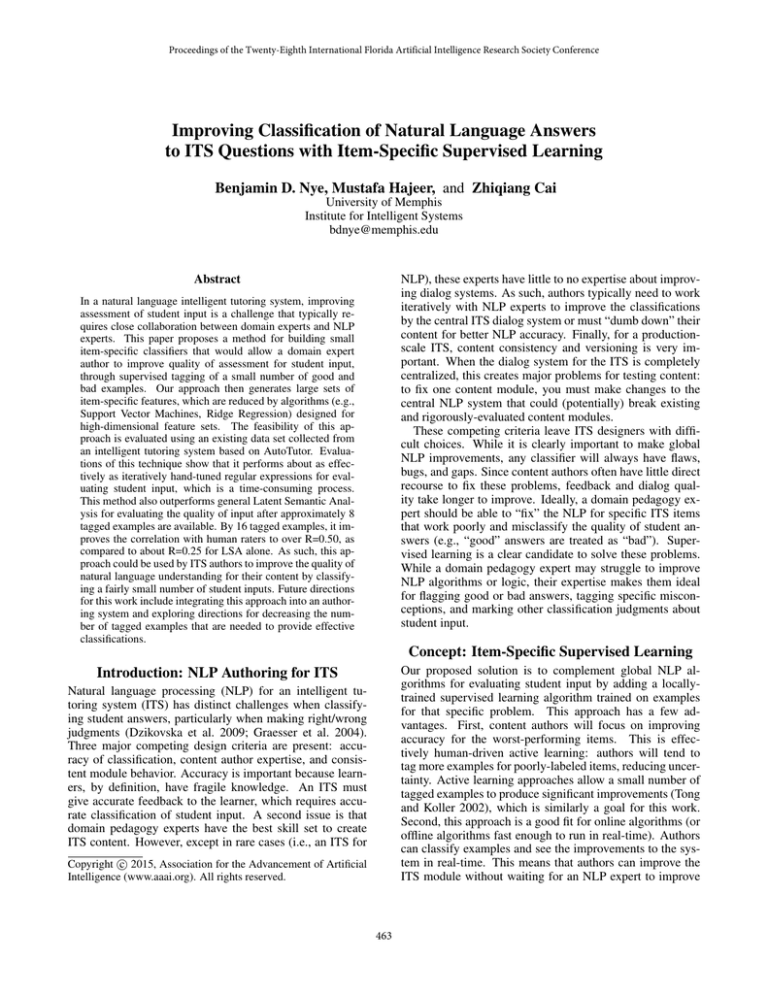
Proceedings of the Twenty-Eighth International Florida Artificial Intelligence Research Society Conference
Improving Classification of Natural Language Answers
to ITS Questions with Item-Specific Supervised Learning
Benjamin D. Nye, Mustafa Hajeer, and Zhiqiang Cai
University of Memphis
Institute for Intelligent Systems
bdnye@memphis.edu
Abstract
NLP), these experts have little to no expertise about improving dialog systems. As such, authors typically need to work
iteratively with NLP experts to improve the classifications
by the central ITS dialog system or must “dumb down” their
content for better NLP accuracy. Finally, for a productionscale ITS, content consistency and versioning is very important. When the dialog system for the ITS is completely
centralized, this creates major problems for testing content:
to fix one content module, you must make changes to the
central NLP system that could (potentially) break existing
and rigorously-evaluated content modules.
These competing criteria leave ITS designers with difficult choices. While it is clearly important to make global
NLP improvements, any classifier will always have flaws,
bugs, and gaps. Since content authors often have little direct
recourse to fix these problems, feedback and dialog quality take longer to improve. Ideally, a domain pedagogy expert should be able to “fix” the NLP for specific ITS items
that work poorly and misclassify the quality of student answers (e.g., “good” answers are treated as “bad”). Supervised learning is a clear candidate to solve these problems.
While a domain pedagogy expert may struggle to improve
NLP algorithms or logic, their expertise makes them ideal
for flagging good or bad answers, tagging specific misconceptions, and marking other classification judgments about
student input.
In a natural language intelligent tutoring system, improving
assessment of student input is a challenge that typically requires close collaboration between domain experts and NLP
experts. This paper proposes a method for building small
item-specific classifiers that would allow a domain expert
author to improve quality of assessment for student input,
through supervised tagging of a small number of good and
bad examples. Our approach then generates large sets of
item-specific features, which are reduced by algorithms (e.g.,
Support Vector Machines, Ridge Regression) designed for
high-dimensional feature sets. The feasibility of this approach is evaluated using an existing data set collected from
an intelligent tutoring system based on AutoTutor. Evaluations of this technique show that it performs about as effectively as iteratively hand-tuned regular expressions for evaluating student input, which is a time-consuming process.
This method also outperforms general Latent Semantic Analysis for evaluating the quality of input after approximately 8
tagged examples are available. By 16 tagged examples, it improves the correlation with human raters to over R=0.50, as
compared to about R=0.25 for LSA alone. As such, this approach could be used by ITS authors to improve the quality of
natural language understanding for their content by classifying a fairly small number of student inputs. Future directions
for this work include integrating this approach into an authoring system and exploring directions for decreasing the number of tagged examples that are needed to provide effective
classifications.
Concept: Item-Specific Supervised Learning
Our proposed solution is to complement global NLP algorithms for evaluating student input by adding a locallytrained supervised learning algorithm trained on examples
for that specific problem. This approach has a few advantages. First, content authors will focus on improving
accuracy for the worst-performing items. This is effectively human-driven active learning: authors will tend to
tag more examples for poorly-labeled items, reducing uncertainty. Active learning approaches allow a small number of
tagged examples to produce significant improvements (Tong
and Koller 2002), which is similarly a goal for this work.
Second, this approach is a good fit for online algorithms (or
offline algorithms fast enough to run in real-time). Authors
can classify examples and see the improvements to the system in real-time. This means that authors can improve the
ITS module without waiting for an NLP expert to improve
Introduction: NLP Authoring for ITS
Natural language processing (NLP) for an intelligent tutoring system (ITS) has distinct challenges when classifying student answers, particularly when making right/wrong
judgments (Dzikovska et al. 2009; Graesser et al. 2004).
Three major competing design criteria are present: accuracy of classification, content author expertise, and consistent module behavior. Accuracy is important because learners, by definition, have fragile knowledge. An ITS must
give accurate feedback to the learner, which requires accurate classification of student input. A second issue is that
domain pedagogy experts have the best skill set to create
ITS content. However, except in rare cases (i.e., an ITS for
c 2015, Association for the Advancement of Artificial
Copyright Intelligence (www.aaai.org). All rights reserved.
463
quire some iterative improvement and are quite difficult for
authors without programming or NLP experience. Our approach tries to harness the pool of student answers more effectively by supporting supervised tags for student answers.
To evaluate our approach, we first compared against earlier benchmarks (Cai et al. 2011) for predicting the 6-point
human rater scale. These earlier approaches required expertdesigned regular expressions that were specific to each item.
For the second analysis, we simplified our classification
scheme to a binary good vs. bad judgment. Ridge Regression with feature selection and support vector machines
(SVM) were used to classify examples (Cortes and Vapnik 1995; Tikhonov et al. 1995). Ridge regression is similar to standard linear regression, but with a smoothing term
that limits overfitting. Feature selection also dropped lowvalue parameters. SVM maps all features into a higherdimensional space, where hyperplanes are used to separate
classes. SVM scales efficiently, so these local classifiers
can process a very large number of features (e.g., a nearly
exhaustive set of keywords), with weight given to features
that are most predictive. These classifiers were trained using SciKit-Learn Python library (Pedregosa and Varoquaux
2011).
A goal of this work is to support very large feature sets
(much larger than the number of tagged examples), which
are then pruned to the small number that are useful to discriminate between student answer categories (in this case,
good vs. bad). In the present paper, the set of features includes: 1) LSA cosine similarity scores to the “ideal answer”
defined by the question author, 2) the logarithm of the number of words in a statement, 3) every word that occurs in at
least 5% of good or bad answers (treated as potential keywords), 4) any existing ordered n-grams of length 2 or 3 of
every keyword, and 5) the count of negation terms in the answer (e.g., “no,” “not,” “n’t” endings), and 6) a binary flag
for an even or odd number of negation terms. The semantic
match and logarithm of words were chosen because related
research showed that these features were highly-predictive
of later test performance (Nye et al. 2014). N-grams were
included due to their success in inclusion in prior successful classifiers, such as entries into the SemEval Joint Student Response Analysis Task (Heilman and Madnani 2013;
Dzikovska et al. 2013). Negations were included because
these play an important role for meaning, and are not handled by traditional LSA approaches.
This approach to keyword detection plays a similar role
as regular expression creation, since it infers candidate keywords for good or bad answers. All analyses were run
using two different tokenization schemes for keywords.
The first method used the Treebank tokenizer and Porter
stemmer from the Natural Language Toolkit (Porter 1980;
Loper and Bird 2002). The second method used a simpler (and much faster) regular expression word-splitting approach. Also, the log of the answer word count is used rather
than the raw number of words, since this has been more predictive of student performance (Nye et al. 2014). The goal
of this large number of features is to capture any key difference between different answer categories. Future work is
expected to iteratively expand the feature set, while apply-
the classifications. Finally, it ensures the consistency of existing ITS modules. Since the supervised learning is used
for item-specific improvement, it does not impact any other
item. These supervised tags could also be used to update the
system’s global NLP algorithms, but our approach means
that global changes can be deferred until the next major version of the system.
In this paper, we focus on evaluating the potential benefits
of this approach to classifying human input to an ITS dialog
system. This work follows in the footsteps of a significant
body of research on short response evaluation, including a
recent SemEval (Semantic Evaluation) Task on Student Response Analysis (Dzikovska et al. 2013). Compared to this
prior body of work, a major focus of this analysis is to consider the number of training examples that are needed to improve the accuracy of classifying human input for an item.
For authors to rely on this method, benefits must be observable after a fairly small number of tagged examples (e.g., 1012). A second ideal characteristic for this approach would
be that the worst-performing items for the global classifier
show significant in accuracy. Assuming that these conditions hold, the proposed methodology should be an effective
method for enhancing ITS natural language understanding.
Method: Classifier Evaluation
Before piloting this approach with real-life ITS authors, it
is important to establish that this approach meets these feasibility conditions (i.e., small number of samples and improves low-performing items). To look at this issue, this paper simulates the process of supervised learning by building
classifiers on an established data set of human-coded student answers to ITS questions. By looking at which items
benefit and the number of tagged examples needed to show
improvements, we can estimate the effort required for the
authors.
In this paper, we are applying this method to improve
AutoTutor answer classifications. AutoTutor is a natural
language ITS that has tutored domains such as computer
literacy, physics, and research methodology (Graesser et
al. 2004; Nye, Graesser, and Hu 2014). AutoTutor converses with users through an expectation-misconception dialog framework: learners are first given an open ended question (typically a “Why” question) and need to explain the
main facets of an ideal explanation (expectations). In the
process, AutoTutor scaffolds the learner by asking more specific answers such as hints (leading questions) or prompts
(fill-in-the-blank) type questions.
In prior research on an ITS for research methodology
based on AutoTutor called Operation ARIES: Acquiring
Research Investigative and Evaluative Skills (Millis et al.
2011), two raters tagged the quality (good vs. not-good) for
a student answers to hint questions (Cai et al. 2011). In that
paper, the ratings were used to evaluate the ability of different linear models to predict the average tagger rating, which
was on a six-point scale. The most effective models considered Latent Semantic Analysis (LSA) cosine similarity,
item-specific regular expressions, and LSA match against
the full pool of student answers (Landauer, Foltz, and Laham 1998; Cai et al. 2011). Of these, regular expressions re-
464
ing classifiers that reduce the number of features in the final
model.
and the ideal answer is also noted. For example, the ideal
answer for Question A was: “A theory is an organized set
of principles that explain why something occurs and allow
for the creation of new predictions. Scientific theories are
tested using strict scientific techniques.” This table shows
some of the limitations of LSA, which would have two correct accepts (A1 and B1), one incorrect rejection (A2), and
one incorrect acceptance (B2). One significant issue is that
the students and raters assume a shared common ground for
the question: A2 does not state the key word “theory,” as
it is implied by the question. B2 has a different issue: because LSA does not handle negations, it cannot distinguish
between “disproved” and “cannot be disproved.” Due to
these issues and others, LSA and similar techniques must
be complemented with other features.
Data Set and Results
The data set used for evaluating our method is described in
Cai et al. (2011), which analyzed the assessment of user input by 21 college students into the Operation ARIES tutoring system for research methodology and critical thinking
(Millis et al. 2011). While that paper looked at students’
long answers and brief answers, in this paper we are focusing on the 1141 long answers, where each answer was
a reply to an AutoTutor main question, which tend to be
open-ended and require the student generate an explanation
(Graesser et al. 2004). Each student answer was matched
against one of 32 ideal answers (i.e., question types).
Two independent coders rated the quality of these answers
against an associated ideal answer, with “1” as completely
wrong and “6” as excellent. These raters tended to score
answers fairly highly (average score of 4.7) and had a reasonable level of correlation (Pearson’s R=0.69). The rater
scores were considered from two perspectives. First, a classifier was trained to predict the average rater score for an
input. This outcome data was used to compare performance
against the work done by Cai et al.. However, the main goal
of this work is to classify the answer type (e.g., identify a
“good answer”). As such, a transform was applied to the
ratings, where an average rating less than 5 was coded as
“not good” and an average >= 5 was coded as “good.” Two
of these ideal answers were excluded from all analyses because they had insufficient examples of bad answers (i.e.,
ratings on all but one answer averaged over 5). Post-hoc exploratory analyses were performed for different thresholds
(4, 4.5, 5.5), but these analyses did not produce any new
intuitions compared to the presented results.
Question
A. Could you
define what a
theory is?
B. Do your best
to provide a
definition for
pseudoscience.
Answer
A1. A theory is an
explanation as to
why something
might happen.
A2. An
explaination of why
something happens
B1. Pseudoscience
means that the
theory proposed
cannot be proven
false.
B2. Pseudoscience
is hypothesis that
are disproved
Avg.
Rating
6
Results: Linear Regression Estimator
The results for the local classifier approach worked about as
effectively as the results Cai et al., but without the need for
hand-tuned regular expressions. For reference, Cai et al. reported Pearson correlations of R=0.28 for LSA and R=0.62
for item-specific regular expressions. Their linear regression
using LSA and word count correlated at R=0.41 to the average rating, and the best-fit model with both LSA and regular
expressions correlated at R=0.67 (using a split sample traintest design).
Using our local classifier approach explained earlier, we
trained and tested Ridge Regression linear estimators using leave-one-out cross-validation. Leave-one-out was chosen due to the relatively small number of tags available for
each item (between 17 and 40 samples). These were compared against the inferences provided by a global LSA score.
Table 2 shows the results (correlations are Pearson’s R).
The LSA regression performed comparably to the Cai et al.
LSA benchmark, while the trained local classifier performed
nearly equivalently to the hand-tuned regular expressions
(which had required multiple iterations of authoring).
LSA
Score
0.61
6
0.06
6
0.66
Measure
Ridge Regr. (Stemmed)
Ridge Regr. (Unstemmed)
LSA
LSA+Word Count (Cai et al.)
LSA+RegEx (Cai et al.)
Overall R
0.67
0.65
0.42
0.41
0.67
Avgi (R)
0.60
0.58
0.40
N/A
N/A
Table 2: Linear Estimator Results
1
Since some items (i) had more examples than others, the
correlation was first calculated for each item-specific estimator and then averaged (Avgi (R)). This shows slightly
worse performance for all estimators, but the same trends
hold. Finally, stemming provided a small benefit of on the
order of 0.02. Across all analyses, this was about the relative level of benefit, so the unstemmed results will not be
presented in later analyses. Overall, these results showed
that despite using fairly “dumb” features (i.e., keywords),
the Ridge Regression was able to match the performance of
the hand-tuned regular expressions. Both estimators may be
0.77
Table 1: Example Questions and Answers
A few examples of questions and associated student answers from this set are noted in Table 1. The question set
is primarily focused on expressing distinctions or relationships between concepts, as opposed to procedural questions
(e.g., calculations). The LSA match between each answer
465
approaching an asymptote due to their source tags as well,
since the human taggers only had an inter-rater correlation
of R=0.69.
is worse than 70%. For those items (18 out of a total of
30), the average LSA correlation was still Avgi (R)=0.25
but Avgi (Acc)=51%. On the same same items, the SVM
classifier had Avgi (R)=0.53 and Avgi (Acc)=78%. So then,
this method does improve poorly-performing items, though
these items still tend to perform slightly worse than other
items. As such, this method offers a reasonable approach for
an author trying to improve system’s assessment of a particular problem that can be expected to correct over half of the
incorrect classifications.
Results: Classifying Good Answers
Next, we examined the accuracy at classifying “good” answers (rating >= 5). This analysis was done using both
SVM (linear kernel) and Ridge Regression, but both provided comparable results with no obvious advantage for either. In this analysis, any item with less than 2 negative examples was excluded since the SVM algorithm would not
work for those items. This meant that a total of 30 items
(ideal answers) and 878 rated answers were analyzed.
A good baseline for this evaluation was difficult to establish, since LSA does not naturally provide a good/bad
classification. Two approaches were used to form a baseline benchmark. The first method was a static threshold for
all problems. However, Penumatsa, P. et al. (2006) reported
that ideal LSA thresholds for classification accuracy tend to
vary based on the ideal answer. As such, a second approach
trained a second SVM that used only LSA as a feature. Unfortunately, the results for this LSA-trained benchmark were
quite bad (Phi R=0.11) and even performed worse than many
static thresholds. While a “floating threshold” is probably
feasible, it may need significant inertia to prevent overfitting a limited sample. As such, rather than showing this
second benchmark, two different LSA cutoff thresholds (0.4
and 0.7) for a “good” answer are reported.
The results for the classifier performance (with stemming) are shown in Table 3. To note, since the outcomes
are dichotomous (0 vs 1) the correlations in this table are
Phi coefficients, also known as Matthew’s correlation coefficients (Cramér 1999; Matthews 1975). The average accuracy across items is also shown (Avgi (Acc)). As with
the prior analysis, adding localized features and supervised
learning to the LSA classifier significantly improves the correlation to the tagged output and increases the overall accuracy. By comparison, the LSA threshold is very conservative
and has poor accuracy when set at common levels of about
0.6 to 0.7. Reducing the threshold to 0.4 improves accuracy,
but is likely to make the tutoring system provide positive
feedback to some entirely incorrect answers. As such, this
“improvement” in accuracy comes with significant practical implications. Overall, the locally-trained SVM is much
more accurate and has a correlation with the human raters
that is nearly twice as strong as LSA alone.
Measure
SVM Classifier
LSA
Overall R
0.58
0.25
Avgi (R)
0.52
0.26
Results: Benefit Per Supervised Tag
While this classifier improves accuracy and correlation with
test classifications, it is also important to look at the number of tags needed to show a benefit. As noted, each item
currently has 17 to 40 tagged answers. If it takes 30 tags
to show noticeable improvement, authors will get frustrated
before reaching that point. To look at this issue, we analyzed
the average benefit for each additional supervised tag for an
item.
Using a Monte Carlo method, 100 sets of tagged answers
were drawn for each item for every number of tagged examples ranging from 6 to 26. Since leave-one-out validation was used, this corresponds to training sets ranging in
size from 5 samples to 25 samples (per item), where each
training set has 100 randomly-selected populations. This
resampling-based approach should damp noise from the random selections. Also, the order of sample selection was randomized, to reduce potential anchoring effects from the human raters (e.g., rating later answers to the same question
based on earlier ones). This methodology required at least
26 samples per item, limiting the analysis to the 23 items
with at least that number (out of 32). Each item answer set
was randomly chosen from that item’s answers, using stratified sampling balanced the number of positive and negative examples. If insufficient positive or negative examples
existed, samples from the remaining class were drawn as
needed.
Figure 1 shows the average quality (Phi R) of the SVM
classifier as a function of the number of samples, as compared to an LSA classifier with a static threshold of 0.4.
Since the LSA classifier does not learn, any variation is due
to random noise or unbalanced sample counts (i.e., insufficient negative examples for certain items). The same analysis was done with a Ridge Regression, which tended to
perform slightly worse than SVM initially but followed the
same general pattern. While the local classifiers correlate
worse than LSA alone for very small sample sizes, they perform comparably by about 7 tagged examples and almost
twice as well after 12 tagged examples. The majority of
gains occur by 16 samples and plateau at about 23 samples
for this data set and features. As shown in Figure 2, this
improvement trend is also evident for the average accuracy.
Unlike the overall correlation, accuracy is always higher because LSA does not use an optimal set of thresholds.
Avgi (Acc)
81%
62% (> 0.4)
37% (> 0.7)
Table 3: “Good Answer” Classifier Results
It is also particularly important to improve classification
of items that are classified poorly by LSA alone. If this
method only improves the well-classified examples, it would
not be very useful for authors. In this analysis, a badlyclassified item is one where the LSA threshold accuracy
466
experimental methods contained fairly distinctive terms and
had limited logical entailment. By comparison, sets such
as those used in the SEMEVAL student response analysis
task involved questions about electrical circuits and other
domains that might be less tractable for the evaluated feature set (Dzikovska et al. 2013). Possible features to add
include explicitly-authored features or tags (e.g., regular expressions), feature clustering, and specialized feature detectors for domain-specific relationships (e.g., math formulas).
For example, the regular expressions applied in prior work
might be used as extra features for this model (Cai et al.
2011).
Another possible direction would be to cluster detected
keyword features. For example, a brief look at the specific
features for given classifiers tended to show multiple synonyms (or even misspellings) of similar concepts. Syntactic clustering (e.g., edit distances) and localized semantic
clustering (e.g., words that serve a similar function for an
item’s answer) might reduce features and increase accuracy
slightly. These types of features, among others, have been
included in effective short-answer assessment ratings such
as the ETS2 entry to SEMEVAL (Heilman and Madnani
2013) and the c-rater system (Sukkarieh and Stoyanchev
2009). Since science and mathematics are common ITS domains, specialized detectors related to formulas and other
domain-specific features could also be valuable.
Finally, work needs to examine how these tagged examples can be used to improve the global classification algorithms for an ITS. If taken to scale, this approach would
quickly build a corpus of tagged examples for supervised
learning. However, each tagged example would be specific
to a given ITS question. Research is needed to identify the
best ways to harness these item-specific examples for more
general supervised learning that improves unsupervised assessment of student inputs to new questions in an ITS.
Figure 1: Classifier Quality (R) as a Function of # Samples
Figure 2: Classifier Accuracy as a Function of # Samples
Discussion and Conclusions
Overall, this approach to analyzing student input to an ITS
seems viable: it offers significant improvements for assessing student input, without requiring a large number of tagged
examples. The performance of this model indicates that a
hybrid approach is probably ideal, where an author needs to
tag a fixed number of examples (e.g., 10) before the local
classifier replaces the default LSA threshold. Future work
might be able to reduce the number of samples required
to reliably improve classifications, such as by using active
learning techniques to suggest examples to tag, by adding
additional features, or by enhancing local classifiers with a
more advanced global model than LSA alone. Since this
work is currently using Support Vector Machines, active
learning is a potential next-step that could be used to suggest informative (i.e., close to an SVM margin) answers that
a human author could tag (Tong and Koller 2002).
While this first exploration was promising, the method
must be applied to more diverse sample sets. Due to the
relatively small number of students and raters, there is a risk
for overfitting regularities in the students’ word choices or
other imbalances in the data set. One direction for followup research is to study these issues, as well as the potential
for active learning to mitigate such effects.
Additional features may be needed for the algorithm generalize to other types of questions. The current data set on
Acknowledgments
This research was supported by the Office of Naval Research
STEM Grand Challenge (N00014-12-C-0643). The ARIES
data set was collected with the support of the Institute of
Education Sciences (R305B070349). The views expressed
in this paper are those of the authors alone.
References
Cai, Z.; Graesser, A.; Forsyth, C.; Burkett, C.; Millis, K.;
Wallace, P.; Halpern, D.; and Butler, H. 2011. Trialog
in ARIES: User input assessment in an intelligent tutoring
system. In Chen, W., and Li, S., eds., Proceedings of the
3rd IEEE International Conference on Intelligent Computing and Intelligent Systems, 429–433. Guangzhou: IEEE
Press.
Cortes, C., and Vapnik, V. 1995. Support-vector networks.
Machine learning 20(3):273–297.
Cramér, H. 1999. Mathematical methods of statistics, volume 9. Princeton University Press.
Dzikovska, M. O.; Callaway, C. B.; Farrow, E.; Moore, J. D.;
Steinhauser, N.; and Campbell, G. 2009. Dealing with interpretation errors in tutorial dialogue. In Proceedings of
467
Porter, M. 1980. An algorithm for suffix stripping. Program
14(3):130–137.
Sukkarieh, J., and Stoyanchev, S. 2009. Automating model
building in c-rater. In Proceedings of the 2009 Workshop on
Applied Textual Inference, 61–69.
Tikhonov, A. N.; Goncharsky, A. V.; Stepanov, V. V.; and
Yagola, A. G. 1995. Regularization methods. In Numerical
Methods for the Solution of Ill-Posed Problems, 7—-63.
Tong, S., and Koller, D. 2002. Support vector machine
active learning with applications to text classification. The
Journal of Machine Learning Research 2:45–66.
the SIGDIAL 2009 Conference: The 10th Annual Meeting
of the Special Interest Group on Discourse and Dialogue,
SIGDIAL ’09, 38–45. Stroudsburg, PA, USA: Association
for Computational Linguistics.
Dzikovska, M. O.; Nielsen, R. D.; Brew, C.; Leacock, C.;
Giampiccolo, D.; Bentivogli, L.; Clark, P.; Dagan, I.; and
Dang, H. T. 2013. SemEval-2013 task 7: The joint student response analysis and 8th recognizing textual entailment challenge. In Proceedings of the 2nd Joint Conference on Lexical and Computational Semantics, 263–274.
Stroudsburg, PA: Association for Computational Linguistics.
Graesser, A. C.; Lu, S.; Jackson, G. T.; Mitchell, H. H.;
Ventura, M.; Olney, A.; and Louwerse, M. M. 2004. AutoTutor: A tutor with dialogue in natural language. Behavior
Research Methods, Instruments, and Computers 36(2):180–
192.
Heilman, M., and Madnani, N. 2013. ETS: domain adaptation and stacking for short answer scoring. In Proceedings of
the 2nd Joint Conference on Lexical and Computational Semantics, 275–279. Stroudsburg, PA: Association for Computational Linguistics.
Landauer, T. K.; Foltz, P. W.; and Laham, D. 1998. An introduction to latent semantic analysis. Discourse Processes
25(2-3):259–284.
Loper, E., and Bird, S. 2002. NLTK: The natural language
toolkit. In Proceedings of the ACL-02 Workshop on Effective
Tools and Methodologies for Teaching Natural Language
Processing and Computational Linguistics, 63–70. Association for Computational Linguistics.
Matthews, B. W. 1975. Comparison of the predicted and observed secondary structure of t4 phage lysozyme. Biochimica et Biophysica Acta -Protein Structure 405(2):442–451.
Millis, K.; Forsyth, C.; Butler, H. A.; Wallace, P.; Graesser,
A. C.; and Halpern, D. F. 2011. Operation ARIES! a serious
game for teaching scientific inquiry. In Ma, M.; Oikonomou,
A.; and Lakhmi, J., eds., Serious Games and Edutainment
Applications. London, UK: Springer. 169–195.
Nye, B. D.; Hajeer, M.; Forsyth, C.; Samei, B.; Hu, X.; and
Millis, K. 2014. Exploring real-time student models based
on natural-language tutoring sessions: A look at the relative importance of predictors. In Educational Data Mining
(EDM) 2014. 253–256.
Nye, B. D.; Graesser, A. C.; and Hu, X. 2014. AutoTutor and Family: A review of 17 years of science and math
tutoring. International Journal of Artificial Intelligence in
Education 24(4):427–469.
Pedregosa, F., and Varoquaux, G. 2011. SciKit-learn: Machine learning in Python. The Journal of Machine Learning
12:2825–2830.
Penumatsa, P.; Ventura, M.; Graesser, A. C.; Louwerse, M.;
Hu, X.; Cai, Z.; and Franceschetti, D. R. 2006. The right
threshold value: What is the right threshold of cosine measure when using latent semantic analysis for evaluating student answers? International Journal on Artificial Intelligence Tools 15(05):767–777.
468

